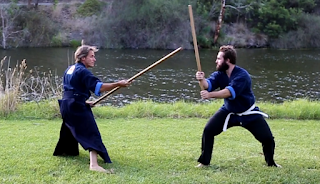Power v's Weight
An interesting topic came up recently at training, speed v’s strength. And as a result, power v's weight ratio. Which is more desirable to the martial arts student, particularly, a student of kobudo?
Those who train in our art realise that speed has the benefits of enabling us better timing, better maai (distancing) and a certain advantage to our strategies. Our arts were not always developed with maximum speed in mind, but without it in our arsenal of tools, we are like a three wheeled wagon. Strength is also a necessity for combat. When locked in an encounter, strength of our legs, core and to some extent, upper body, are vital. But how much strength is really necessary? And what sacrifice do we have to make in terms of overall weight? How much muscle is too much weight to carry? How light do we need to be for speed without sacrificing strength?
In May of this year, on our visit to the hombu, Sensei discussed the issue with us over a delicious meal and a “few” warm cups of sake ;-) His thoughts, were that the issue of speed and strength comes down to a power/weight ratio. There is no use being 195cm (6’4” approx) tall and weighing in at 120kg’s (250lbs approx). He said, “You will be too slow!” Sensei was stating this rationale with the assumption that the weight you are carrying is more muscle than fat. He believes, the proper ratio for martial artists is your height in centimetres minus 100. You are then left with your ideal weight in kilograms.
Example, I am 179cm tall (5’11” approx) and weigh 75kg. By Sensei’s reckoning, I am 4kg’s under weight. However, being long limbed and an athletic build, I would say I am about the right power to weight ratio for my build and height. His formula is an approximate only. It was understood, as we talked more, that this is a rough calculation. A few kilo’s either side is fine. What is more important with this formula, is that you feel strong, fast and quick on your feet. As I say to my students often, there are no excuses for not being able to move what you have. If you can’t, then there are two simple choices: Get faster or get lighter.
Example, I am 179cm tall (5’11” approx) and weigh 75kg. By Sensei’s reckoning, I am 4kg’s under weight. However, being long limbed and an athletic build, I would say I am about the right power to weight ratio for my build and height. His formula is an approximate only. It was understood, as we talked more, that this is a rough calculation. A few kilo’s either side is fine. What is more important with this formula, is that you feel strong, fast and quick on your feet. As I say to my students often, there are no excuses for not being able to move what you have. If you can’t, then there are two simple choices: Get faster or get lighter.
There are times I feel strong, but not always fast and vice versa. For me, I have felt my best on the mats when lighter than 75kg’s by a little margin. However I will add, that I was doing a lot of surfing and interval running, so muscle strength was still present while being a little lighter seemed to help a lot for my movement and overall stamina.
What works best for you? A lot of us don’t assess these matters much unless we’re trying to get into an old pair of jeans, or our training starts to plateau, right? We tend to go along happily with our training at much the same weight and conditioning level. Active people don’t tend to oscillate much with their weight. However, if you’ve noticed a deficiency in your movement and training, or you’re just not progressing, perhaps you haven’t really assessed this power/weight ratio. Perhaps it’s time to have an objective look at your physicality and make the necessary adjustments?
Travis de Clifford
Katsuyoshi
Dojocho - Kensho Dojo


Comments